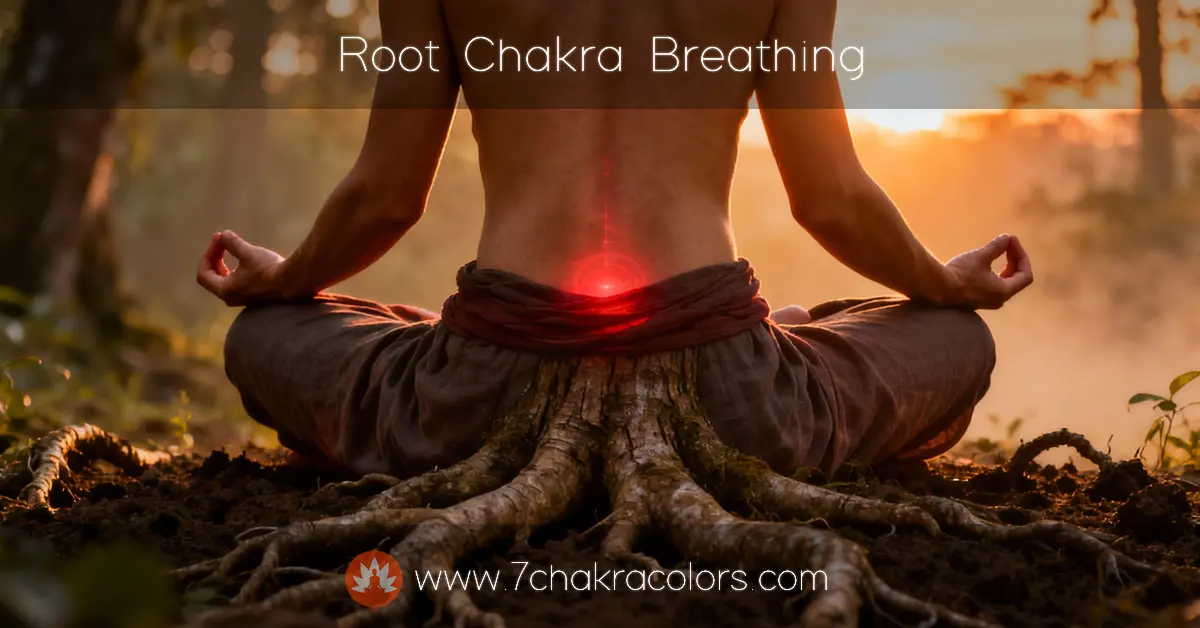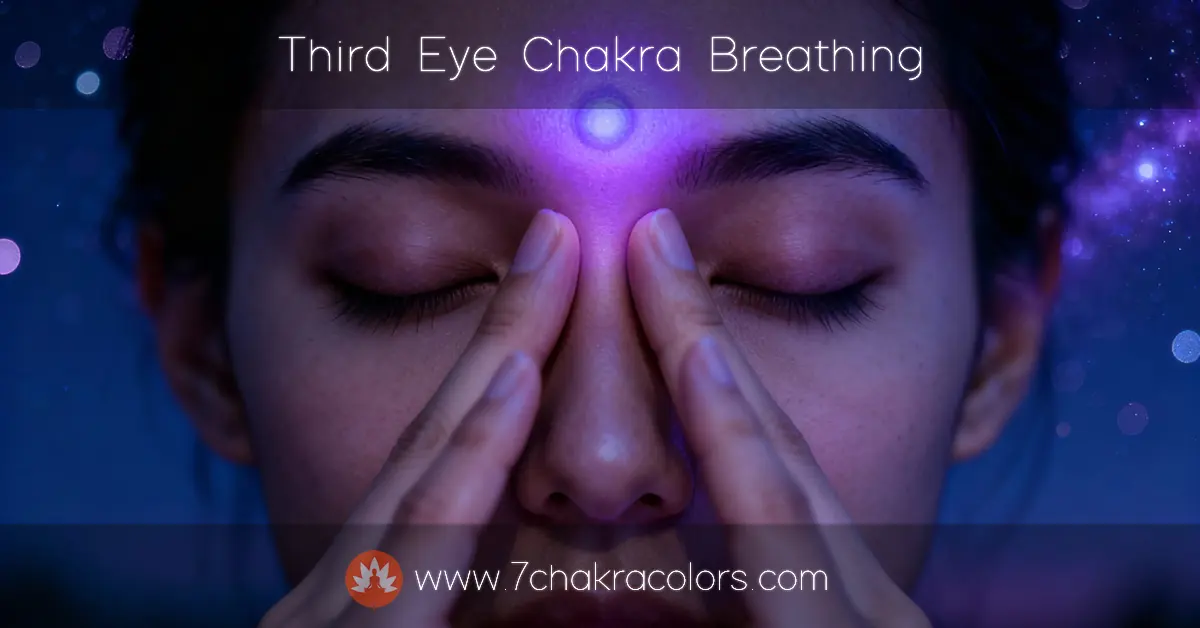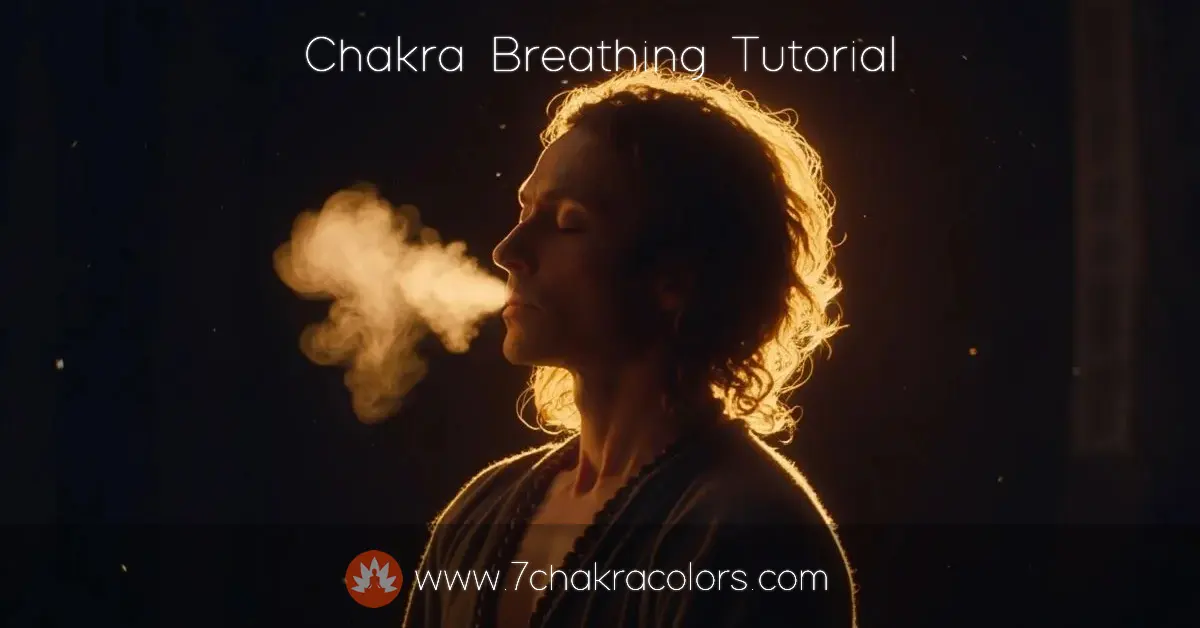

Master throat chakra breathing techniques to find your authentic voice. Learn 9 powerful exercises from Ujjayi to HAM mantra for clear communication and confident expression.
Your throat chakra sits right at your neck. Center of your throat, where sound originates. When it's blocked, words get stuck. You can't say what you mean. Either nothing comes out, or everything comes out wrong - too harsh, too apologetic, not authentic.
Throat chakra breathing clears that stuck energy fast. These techniques open your voice, strengthen your authentic expression, let your truth flow. The tightness in your throat releases. Words start coming naturally.
Here's what you'll learn:
To learn more about basic chakra breathwork, take a look at the main article explaining breathing and chakras.
The throat chakra - Vishuddha in Sanskrit - governs all communication. Speaking your truth. Expressing yourself authentically. Being heard. But also listening - really listening, not just waiting to talk.
Located at your throat, but extending to your jaw, neck, shoulders, ears. Associated with blue energy and the space element - ether. When it's open, words flow naturally. You say what you mean. People understand you. You don't overthink every sentence or swallow your truth to keep peace.
When it's blocked? The symptoms are obvious.
Can't speak up in meetings even when you have something valuable to say. Over-explaining everything because you don't trust that your point came across. Either talking too much - filling every silence with words - or barely talking at all. Lying, even about small things, because truth feels too vulnerable. That chronic lump in your throat that never quite goes away.
Your body shows throat problems clearly. Chronic sore throats with no infection. Voice that gets hoarse easily. Jaw tension that clenches at night. Neck stiffness no amount of stretching fixes. Issues with your thyroid - either overactive or sluggish.
That feeling like something's literally stuck in your throat. The physical manifestation of unexpressed words.
Air moves through your throat with every breath. Each inhale and exhale passes directly through Vishuddha. When you breathe consciously into this area, directing attention and intention there, you're activating the energy center that controls your voice.
Breath carries sound. Before words, there's breath. Before expression, there's the air moving through your throat creating vibration. Breathing exercises for throat chakra work because they strengthen the connection between breath, voice, and authentic expression.
Start here. Foundation for everything else.

Sometimes the shift is immediate. That restricted feeling in your throat eases. Words feel more accessible. Like you could actually say what you're thinking if you needed to.
Other times it builds gradually. After consistent practice, you notice you speak up more easily. Don't rehearse conversations fifty times before having them. Can express disagreement without either shutting down or getting defensive.
This classic pranayama directly activates your throat chakra by creating friction in your throat as you breathe.
Ujjayi breath strengthens your throat chakra by creating sustained, gentle friction there. The sound itself is soothing - regulates your nervous system while activating your voice center. Use it before any situation requiring clear communication.
This pranayama balances the energy channels that meet at your throat. When these channels are balanced, your communication becomes clearer, more authentic.
This technique calms the nervous system, which is crucial for throat chakra work. When you're anxious, your throat tightens. Can't speak clearly. This breathing pattern creates the calm necessary for authentic expression.
This combines breath with visualization for deeper throat chakra activation.
Blue is the throat chakra's color - representing clear communication, truth, authenticity. When you can't access clear expression naturally, visualization creates the energetic pattern. Your throat chakra responds.
This simple technique releases stuck energy in your throat immediately. Surprisingly powerful.
Sighing is your body's natural way of releasing tension. This technique harnesses that mechanism specifically for your throat chakra. Most people feel immediate relief - like pressure they didn't know they were carrying just lifted.
This advanced technique uses Jalandhara Bandha - the throat lock - combined with breath retention to powerfully activate Vishuddha.
Warning: Don't force this technique. The throat lock should feel like gentle pressure, not strain. If you have neck issues or high blood pressure, skip this one or work with a qualified teacher.
When done correctly, breath retention with throat lock creates intense activation in your throat chakra. Builds energy there. Strengthens your capacity for clear, powerful expression.
This pranayama directly stimulates your throat, tongue, and jaw. Powerful and slightly ridiculous - which helps break through self-consciousness about using your voice.
Lion's Breath releases inhibition around using your voice. Forces you to make sound, stretch your throat, engage your voice mechanism fully. Most people feel energized and less self-conscious after just a few rounds.
Bhramari - bee breath - creates sustained vibration in your throat. The humming activates your throat chakra through sound and sensation.
Bee breath calms the nervous system while activating the throat chakra. The vibration literally massages your throat from the inside. Many people feel immediate clarity after this practice - like mental fog lifted.
Every chakra has a seed sound. For the throat chakra, it's HAM (pronounced "hum"). The vibration resonates at this chakra's frequency.
The HAM mantra activates your throat chakra faster than breath alone. You'll feel the resonance building, the stuck energy starting to move, your voice mechanism waking up.
Each technique serves different purposes. Here's the breakdown:
| Technique | Best Used For | Difficulty Level | Time Needed |
|---|---|---|---|
| Basic Throat-Centered Breathing | Daily practice, beginners, building foundation | Beginner | 5-10 minutes |
| Ujjayi Breath | Before communication, strengthening voice, calming nerves | Beginner | 5-10 minutes |
| Alternate Nostril Breathing | Balancing energy, calming anxiety, preparing to speak | Intermediate | 5-10 minutes |
| Blue Light Breathing | Visualization practice, deep throat chakra work | Beginner | 10-15 minutes |
| Sigh Breathing | Quick release, immediate relief, releasing stuck words | Beginner | 2-3 minutes |
| Breath Retention with Throat Lock | Advanced activation, building throat strength, experienced practitioners | Advanced | 3-5 minutes |
| Lion's Breath | Breaking through self-consciousness, releasing inhibition, energizing | Beginner | 2-3 minutes |
| Bee Breath | Internal vibration, calming while activating, mental clarity | Intermediate | 3-5 minutes |
| HAM Mantra | Direct chakra activation, sound healing, fast results | Beginner | 5-10 minutes |
Morning works well - clearing your throat chakra before you need to communicate all day. But these techniques are useful anytime you need to speak up and can't. Before presentations. Job interviews. Difficult conversations where you know you need to say something hard.
When you've been swallowing your words for days and that lump in your throat won't go away. After arguments where you either said too much or not enough. Anytime your authentic voice feels inaccessible.
Five minutes of Ujjayi breath or Lion's Breath before speaking situations changes everything. Your throat opens. Words come more easily. You sound like yourself.
Throat chakra breathing exercises become more powerful when paired with complementary work. Do your breathwork, then practice throat chakra meditation to deepen the opening. Use blue crystals like turquoise or aquamarine during your breathing practice.
Singing strengthens your throat chakra - doesn't matter if you think you can sing or not. Journaling helps clarify what you actually want to say before you need to say it out loud. Neck stretches release physical tension that blocks your voice.
Using these breathing techniques can trigger throat chakra opening symptoms. You'll notice shifts in how you communicate.
Speaking up becomes easier. You contribute to meetings without rehearsing fifty times first. Can express disagreement without shutting down or getting aggressive. Say "no" when you mean no, without elaborate justifications.
Your voice sounds clearer, stronger. People stop asking you to repeat yourself. You don't trail off at the end of sentences or up-speak, turning statements into questions.
Authenticity appears naturally. You say what you actually think instead of what you think people want to hear. Stop over-explaining. Trust that your words are enough.
Listening improves. When your own throat chakra is open, you can actually hear others instead of just formulating your response while they talk.
That chronic throat tightness releases. Jaw tension decreases. You stop clenching your teeth at night. Neck stiffness improves.
Your voice gains resonance. Sounds fuller, more grounded. Doesn't get hoarse as easily. Thyroid function often normalizes as throat chakra energy balances.
Forcing sound. These techniques should feel natural, not strained. If your throat hurts, you're pushing too hard.
Practicing only when you're already anxious about speaking. These work better as regular maintenance. Build throat chakra strength before you desperately need it.
Expecting immediate vocal confidence after one practice. Throat chakra opening takes time, especially if you've been silencing yourself for years.
Confusing throat chakra opening with talking more. An open throat chakra doesn't mean constant talking. It means authentic communication - which includes knowing when to speak and when to listen.
Start with basic throat-centered breathing. Five minutes every morning for one week. Just building awareness of your throat center.
Week two, add Ujjayi breath. Practice it throughout the day - walking, sitting, whenever you remember.
Week three, incorporate one sound technique - Lion's Breath or HAM mantra. Feel the vibration activating your throat.
Week four, use specific techniques before situations requiring clear communication. Notice how it changes your ability to speak authentically.
Track subtle shifts. "Spoke up in meeting" or "Said what I actually meant" or "Didn't apologize unnecessarily." Small changes compound into transformed communication.
Everything requiring authentic expression flows through your throat chakra. When it's blocked, your truth stays stuck inside. You know what you want to say but can't access the words. Or the words come out wrong, distorted by fear or old patterns.
These breathing techniques reconnect you with your authentic voice. Not through years of therapy or communication workshops. Through five minutes of conscious breathing. Into your throat. With intention.
Your throat wants to be open. Your voice wants to flow naturally. The tightness, the stuck feeling, the words you swallow - those are protective responses that served you once but probably don't anymore. Breath dissolves them gently, creating space for genuine expression.
Try basic throat-centered breathing tomorrow morning. Hand on throat, breathing blue light into your neck, releasing stuck words. Five minutes. Notice what opens.
Breathing opens the throat chakra because air passes directly through your throat with every breath. When you breathe consciously into this area with specific techniques like Ujjayi or throat-centered breathing, you're activating the energy center that controls communication and expression. The breath carries vibration and sound, strengthening your voice mechanism and clearing stuck energy that blocks authentic expression.
Some people feel immediate relief after just five minutes - that throat tightness eases, words feel more accessible. For deeper transformation in how you communicate, consistent daily practice over weeks creates lasting changes. Your patterns of silencing yourself or miscommunicating developed over years, so genuine throat chakra opening requires patience and regular practice to rewire those habits.
Yes. Throat chakra breathing techniques calm the nervous system while activating your voice center. Practices like Ujjayi breath and alternate nostril breathing reduce anxiety before speaking situations. Lion's Breath specifically breaks through self-consciousness about using your voice. Regular practice builds genuine vocal confidence rather than just managing fear, making public speaking feel more natural over time.
Morning practice clears your throat chakra before you need to communicate all day. But these techniques work powerfully right before any situation requiring clear expression - presentations, difficult conversations, job interviews, or anytime you need to speak your truth. Five minutes of focused breathwork immediately before speaking changes how your words flow and how confidently you express yourself.
No. An open throat chakra doesn't mean constant talking - it means authentic communication. You speak when you have something genuine to say and listen when others are speaking. If you currently talk too much or dominate conversations, throat chakra work actually helps you communicate more effectively with less words. Balance means knowing when to speak and when to be quiet.
Blue is the throat chakra's color, so visualizing blue light amplifies the effect of breathwork. But if visualization doesn't come naturally, just focusing on the physical sensations of breath moving through your throat works fine. Some people prefer feeling the coolness of inhales across their throat or noticing vibration during sound-based techniques. Use whatever method helps you connect with your throat center.
Yes. When your throat chakra is blocked, words come out distorted - either too harsh, too apologetic, or completely misrepresenting what you actually mean. Throat chakra breathing creates the space between feeling and speaking where you can choose authentic words. Combined with practices like journaling to clarify your thoughts first, breathwork helps you express yourself more accurately and genuinely.
You'll feel physical sensations - warmth in your throat, tingling, release of chronic tightness, easier swallowing. Your voice might sound clearer or stronger immediately after practice. Emotionally, words feel more accessible. That stuck feeling lifts. After consistent practice, you notice you speak up more naturally, express yourself authentically without rehearsing, and communicate with less anxiety and more confidence.
Absolutely. Throat chakra breathing pairs powerfully with meditation, singing, chanting, journaling, and neck stretches. Use blue crystals like turquoise or aquamarine during breathwork to amplify effects. Follow breathwork with throat chakra meditation to deepen the opening. Singing after breathing practice strengthens your voice mechanism. These complementary practices create faster and more lasting transformation.
Some tightness is normal as blocked energy releases, but pain means you're forcing. Back off intensity. Start with gentler techniques like basic throat-centered breathing or sigh breathing. Avoid advanced practices like breath retention with throat lock until you build capacity. If tightness persists, it might indicate stuck emotions that need gentler processing - consider journaling or working with a practitioner alongside breathwork.






